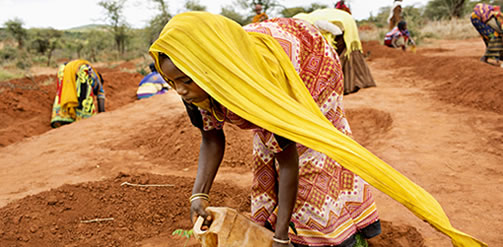Given that 90 per cent of recorded major disasters caused by natural hazards from 1995 to 2015 were linked to weather and climate change, there is an urgent need to protect and prepare the most vulnerable to respond. The new IDS Bulletin, Courting Catastrophe? Humanitarian Policy and Practice in a Changing Climate, argues that humanitarian aid and climate change sectors need to work together to support adaptation in the long-term and not solely focus on short-term responses.

The editors, Siri Eriksen, Ruth Haug, Lars Otto Naess, Aditi Bhonagiri and Lutgart Lenaerts, question whether or not humanitarian aid should remain focused on ‘saving lives in the time of crises – or also engage in longer-term concerns, including climate change’.
They argue that ‘humanitarian crises appear dramatic, overwhelming and sudden. Aid is required immediately to save lives. On the face of it, linkages to longer-term climate change and adaptation appear far-fetched. However, the causes for humanitarian crises – such as the current food shortages in Ethiopia and on the Horn of Africa – are rarely sudden’.
Political and financial frameworks are needed to facilitate longer-term actions; alongside taking into account the experience and knowledge of local communities, and those directly impacted by climate change.
The research that has contributed to the Bulletin, from the Courting Catastrophe initiative, is the result of thinking between academic and humanitarian organisations across the globe. As demonstrated within the collection of articles, they explore the ways in which humanitarian responses are affecting the prospects for adaptation to climate change in different geographic and policy contexts, with a focus on Bangladesh, Ethiopia, Kenya, Pakistan, Malawi, Nepal and Zambia.
Over recent years, a number of humanitarian organisations have been shifting into longer-term activities, through work on disaster risk reduction (DRR), and more recently, a growing focus on strengthening resilience to climate change as a cross-cutting goal among various humanitarian actors. While there is an increasing acknowledgement of the need to make such linkages, it is also clear that there are cultural, institutional and financial obstacles for making this work in practice.
Many organisations are now building their capacity to understand what needs to be done differently. IDS is also running a short course on Integrating Disaster Risk Reduction and Climate Change (deadline to apply is 2 October). This short course aims to equip policymakers and practitioners with the knowledge and skills to more effectively integrate disaster risk reduction with adaptation to climate change, in the context of development and poverty reduction.
The editors conclude that ‘adaptation policy and practice has a lot to learn from humanitarian practice. Humanitarian actors have decades of experience working directly with vulnerable populations in complex settings, which forms a good entry point for a deep understanding of the types of changes in social and political relations that deliberate transformation would require.’
For those interested in addressing these long-term challenges access all the articles for free to download on the IDS Bulletin website.